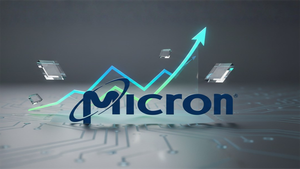
The global technology landscape, as of October 2025, is witnessing a profound transformation, with energy-efficient semiconductors emerging as a pivotal force driving both market surges on the Nasdaq and unprecedented innovation across the artificial intelligence (AI) sector. This isn't merely a trend; it's a fundamental shift towards sustainable and powerful computing, where the ability to process more data with less energy is becoming the bedrock of next-generation AI. Companies at the forefront of this revolution, such as Enphase Energy (NASDAQ: ENPH), are not only demonstrating the tangible benefits of these advanced components in critical applications like renewable energy but are also acting as bellwethers for the broader market's embrace of efficiency-driven technological progress.
The immediate significance of this development is multifaceted. On one hand, the insatiable demand for AI compute, from large language models to complex machine learning algorithms, necessitates hardware that can handle immense workloads without prohibitive energy consumption or thermal challenges. Energy-efficient semiconductors, including those leveraging advanced materials like Gallium Nitride (GaN) and Silicon Carbide (SiC), are directly addressing this need. On the other hand, the financial markets, particularly the Nasdaq, are keenly reacting to these advancements, with technology stocks experiencing significant gains as investors recognize the long-term value and strategic importance of companies innovating in this space. This symbiotic relationship between energy efficiency, AI development, and market performance is setting the stage for the next era of technological breakthroughs.
The Engineering Marvels Powering AI's Green Future
The current surge in AI capabilities is intrinsically linked to groundbreaking advancements in energy-efficient semiconductors, which are fundamentally reshaping how data is processed and energy is managed. These innovations represent a significant departure from traditional silicon-based computing, pushing the boundaries of performance while drastically reducing power consumption – a critical factor as AI models grow exponentially in complexity and scale.
At the forefront of this revolution are Wide Bandgap (WBG) semiconductors, notably Gallium Nitride (GaN) and Silicon Carbide (SiC). Unlike conventional silicon, these materials boast wider bandgaps (3.3 eV for SiC, 3.4 eV for GaN, compared to silicon's 1.1 eV), allowing them to operate at higher voltages and temperatures with dramatically lower power losses. Technically, SiC devices can withstand over 1200V, while GaN excels up to 900V, far surpassing silicon's practical limit around 600V. GaN's exceptional electron mobility enables near-lossless switching at megahertz frequencies, reducing switching losses by over 50% compared to SiC and significantly improving upon silicon's sub-100 kHz capabilities. This translates into smaller, lighter power circuits, with GaN enabling compact 100W fast chargers and SiC boosting EV powertrain efficiency by 5-10%. As of October 2025, the industry is scaling up GaN wafer sizes to 300mm to meet soaring demand, with WBG devices projected to halve power conversion losses in renewable energy and EV applications.
Enphase Energy's (NASDAQ: ENPH) microinverter technology serves as a prime example of these principles in action within renewable energy systems. Unlike bulky central string inverters that convert DC to AC for an entire array, Enphase microinverters are installed under each individual solar panel. This distributed architecture allows for panel-level Maximum Power Point Tracking (MPPT), optimizing energy harvest from each module regardless of shading or individual panel performance. The IQ7 series already achieves up to 97% California Energy Commission (CEC) efficiency, and the forthcoming IQ10C microinverter, expected in Q3 2025, promises support for next-generation solar panels exceeding 600W with enhanced power capabilities and thermal management. This modular, highly efficient, and safer approach—keeping DC voltage on the roof to a minimum—stands in stark contrast to the high-voltage DC systems of traditional inverters, offering superior reliability and granular monitoring.
Beyond power conversion, neuromorphic computing is emerging as a radical solution to AI's energy demands. Inspired by the human brain, these chips integrate memory and processing, bypassing the traditional von Neumann bottleneck. Using spiking neural networks (SNNs), they achieve ultra-low power consumption, targeting milliwatt levels, and have demonstrated up to 1000x energy reductions for specific AI tasks compared to power-hungry GPUs. While not directly built from GaN/SiC, these WBG materials are crucial for efficiently powering the data centers and edge devices where neuromorphic systems are being deployed. With 2025 hailed as a "breakthrough year," neuromorphic chips from Intel (NASDAQ: INTC – Loihi), BrainChip (ASX: BRN – Akida), and IBM (NYSE: IBM – TrueNorth) are entering the market at scale, finding applications in robotics, IoT, and real-time cognitive processing.
The AI research community and industry experts have universally welcomed these advancements, viewing them as indispensable for the sustainable growth of AI. Concerns over AI's escalating energy footprint—with large language models requiring immense power for training—have been a major driver. Experts emphasize that without these hardware innovations, the current trajectory of AI development would be unsustainable, potentially leading to a plateau in capabilities due to power and cooling limitations. Neuromorphic computing, despite its developmental challenges, is particularly lauded for its potential to deliver "dramatic" power reductions, ushering in a "new era" for AI. Meanwhile, WBG semiconductors are seen as critical enablers for next-generation "AI factory" computing platforms, facilitating higher voltage power architectures (e.g., NVIDIA's 800 VDC) that dramatically reduce distribution losses and improve overall efficiency. The consensus is clear: energy-efficient hardware is not just optimizing AI; it's defining its future.
Reshaping the AI Landscape: Competitive Implications and Market Dynamics
The advent of energy-efficient semiconductors is not merely an incremental upgrade; it is fundamentally reshaping the competitive landscape for AI companies, tech giants, and nascent startups alike. As of October 2025, the AI industry's insatiable demand for computational power has made energy efficiency a non-negotiable factor, transitioning the sector from a purely software-driven boom to an infrastructure and energy-intensive build-out.
The most immediate beneficiaries are the operational costs and sustainability profiles of AI data centers. With rack densities soaring from 8 kW to 17 kW in just two years and projected to hit 30 kW by 2027, the energy consumption of AI workloads is astronomical. Energy-efficient chips directly tackle this, leading to substantial reductions in power consumption and heat generation, thereby slashing operational expenses and fostering more sustainable AI deployment. This is crucial as AI systems are on track to consume nearly half of global data center electricity this year. Beyond cost, these innovations, including chiplet architectures, heterogeneous integration, and advanced packaging, unlock unprecedented performance and scalability, allowing for faster training and more efficient inference of increasingly complex AI models. Crucially, energy-efficient chips are the bedrock of the burgeoning "edge AI" revolution, enabling real-time, low-power processing on devices, which is vital for robotics, IoT, and autonomous systems.
Leading the charge are semiconductor design and manufacturing giants. NVIDIA (NASDAQ: NVDA) remains a dominant force, actively integrating new technologies and building next-generation 800-volt DC data centers for "gigawatt AI factories." Intel (NASDAQ: INTC) is making an aggressive comeback with its 2nm-class GAAFET (18A) technology and its new 'Crescent Island' AI chip, focusing on cost-effective, energy-efficient inference. Advanced Micro Devices (NASDAQ: AMD) is a strong competitor with its Instinct MI350X and MI355X GPUs, securing major partnerships with hyperscalers. TSMC (NYSE: TSM), as the leading foundry, benefits immensely from the demand for these advanced chips. Specialized AI chip innovators like BrainChip (ASX: BRN), IBM (NYSE: IBM – via its TrueNorth project), and Intel with its Loihi are pioneering neuromorphic chips, offering up to 1000x energy reductions for specific edge AI tasks. Companies like Vertical Semiconductor are commercializing vertical Gallium Nitride (GaN) transistors, promising up to 30% power delivery efficiency improvements for AI data centers.
While Enphase Energy (NASDAQ: ENPH) isn't a direct producer of AI computing chips, its role in the broader energy ecosystem is increasingly relevant. Its semiconductor-based microinverters and home energy solutions contribute to the stable and sustainable energy infrastructure that "AI Factories" critically depend on. The immense energy demands of AI are straining grids globally, making efficient, distributed energy generation and storage, as provided by Enphase, vital for localized power solutions or overall grid stability. Furthermore, Enphase itself is leveraging AI within its platforms, such as its Solargraf system, to enhance efficiency and service delivery for solar installers, exemplifying AI's pervasive integration even within the energy sector.
The competitive landscape is witnessing significant shifts. Major tech giants like Google (NASDAQ: GOOGL), Amazon (NASDAQ: AMZN), Microsoft (NASDAQ: MSFT), and even OpenAI (via its partnership with Broadcom (NASDAQ: AVGO)) are increasingly pursuing vertical integration by designing their own custom AI accelerators. This strategy provides tighter control over cost, performance, and scalability, reducing dependence on external chip suppliers. Companies that can deliver high-performance AI with lower energy requirements gain a crucial competitive edge, translating into lower operating costs and more practical AI deployment. This focus on specialized, energy-efficient hardware, particularly for inference workloads, is becoming a strategic differentiator, while the escalating cost of advanced AI hardware could create higher barriers to entry for smaller startups, potentially centralizing AI development among well-funded tech giants. However, opportunities abound for startups in niche areas like chiplet-based designs and ultra-low power edge AI.
The Broader Canvas: AI's Sustainable Future and Unforeseen Challenges
The deep integration of energy-efficient semiconductors into the AI ecosystem represents a pivotal moment, shaping the broader AI landscape and influencing global technological trends. As of October 2025, these advancements are not just about faster processing; they are about making AI sustainable, scalable, and economically viable, addressing critical concerns that could otherwise impede the technology's exponential growth.
The exponential growth of AI, particularly large language models (LLMs) and generative AI, has led to an unprecedented surge in computational power demands, making energy efficiency a paramount concern. AI's energy footprint is substantial, with data centers projected to consume up to 1,050 terawatt-hours by 2026, making them the fifth-largest electricity consumer globally, partly driven by generative AI. Energy-efficient chips are vital to making AI development and deployment scalable and sustainable, mitigating environmental impacts like increased electricity demand, carbon emissions, and water consumption for cooling. This push for efficiency also enables the significant shift towards Edge AI, where processing occurs locally on devices, reducing energy consumption by 100 to 1,000 times per AI task compared to cloud-based AI, extending battery life, and fostering real-time operations without constant internet connectivity.
The current AI landscape, as of October 2025, is defined by an intense focus on hardware innovation. Specialized AI chips—GPUs, TPUs, NPUs—are dominating, with companies like NVIDIA (NASDAQ: NVDA), AMD (NASDAQ: AMD), and Intel (NASDAQ: INTC) pushing the boundaries. Emerging architectures like chiplets, heterogeneous integration, neuromorphic computing (seeing a "breakthrough year" in 2025 with devices like Intel's Loihi and IBM's TrueNorth offering up to 1000x energy reductions for specific tasks), in-memory computing, and even photonic AI chips are all geared towards minimizing energy consumption while maximizing performance. Gallium Nitride (GaN) AI chips, like those from Vertical Semiconductor, are aiming to stack transistors vertically to improve data center efficiency by up to 30%. Even AI itself is being leveraged to design more energy-efficient chips and optimize manufacturing processes.
The impacts are far-reaching. Environmentally, these semiconductors directly reduce AI's carbon footprint and water usage, contributing to global sustainability goals. Economically, lower power consumption slashes operational costs for AI deployments, democratizing access and fostering a more competitive market. Technologically, they enable more sophisticated and pervasive AI, making complex tasks feasible on battery-powered edge devices and accelerating scientific discovery. Societally, by mitigating AI's environmental drawbacks, they contribute to a more sustainable technological future. Geopolitically, the race for advanced, energy-efficient AI hardware is a key aspect of national competitive advantage, driving heavy investment in infrastructure and manufacturing.
However, potential concerns temper the enthusiasm. The sheer exponential growth of AI computation might still outpace improvements in hardware efficiency, leading to continued strain on power grids. The manufacturing of these advanced chips remains resource-intensive, contributing to e-waste. The rapid construction of new AI data centers faces bottlenecks in power supply and specialized equipment. High R&D and manufacturing costs for cutting-edge semiconductors could also create barriers. Furthermore, the emergence of diverse, specialized AI architectures might lead to ecosystem fragmentation, requiring developers to optimize for a wider array of platforms.
This era of energy-efficient semiconductors for AI is considered a pivotal moment, analogous to previous transformative shifts. It mirrors the early days of GPU acceleration, which unlocked the deep learning revolution, providing the computational muscle for AI to move from academia to the mainstream. It also reflects the broader evolution of computing, where better design integration, lower power consumption, and cost reductions have consistently driven progress. Critically, these innovations represent a concerted effort to move "beyond Moore's Law," overcoming the physical limits of traditional transistor scaling through novel architectures like chiplets and advanced materials. This signifies a fundamental shift, where hardware innovation, alongside algorithmic breakthroughs, is not just improving AI but redefining its very foundation for a sustainable future.
The Horizon Ahead: AI's Next Evolution Powered by Green Chips
The trajectory of energy-efficient semiconductors and their symbiotic relationship with AI points towards a future of unprecedented computational power delivered with a dramatically reduced environmental footprint. As of October 2025, the industry is poised for a wave of near-term and long-term developments that promise to redefine AI's capabilities and widespread integration.
In the near term (1-3 years), expect to see AI-optimized chip design and manufacturing become standard practice. AI algorithms are already being leveraged to design more efficient chips, predict and optimize energy consumption, and dynamically adjust power usage based on real-time workloads. This "AI designing chips for AI" approach, exemplified by TSMC's (NYSE: TSM) tenfold efficiency improvements in AI computing chips, will accelerate development and yield. Specialized AI architectures will continue their dominance, moving further away from general-purpose CPUs towards GPUs, TPUs, NPUs, and VPUs specifically engineered for AI's matrix operations. Companies like Google (NASDAQ: GOOGL), Amazon (NASDAQ: AMZN), and Microsoft (NASDAQ: MSFT) are heavily investing in custom silicon to optimize for inference tasks and reduce power draw. A significant shift towards Edge AI and on-device processing will also accelerate, with energy-efficient chips enabling a 100 to 1,000-fold reduction in energy consumption for AI tasks on smartphones, wearables, autonomous vehicles, and IoT sensors. Furthermore, advanced packaging technologies like 3D integration and chip stacking will become critical, minimizing data travel distances and reducing power consumption. The continuous miniaturization to 3nm and 2nm process nodes, alongside the wider adoption of GaN and SiC, will further enhance efficiency, with MIT researchers having developed a low-cost, scalable method to integrate high-performance GaN transistors onto standard silicon CMOS chips.
Looking further ahead (3-5+ years), radical transformations are on the horizon. Neuromorphic computing, mimicking the human brain, is expected to reach broader commercial deployment, offering unparalleled energy efficiency (up to 1000x reductions for specific AI tasks) by integrating memory and processing. In-Memory Computing (IMC), which processes data where it's stored, will gain traction, significantly reducing energy-intensive data movement. Photonic AI chips, using light instead of electricity, promise a thousand-fold increase in energy efficiency, redefining high-performance AI for specific high-speed, low-power tasks. The vision of "AI-in-Everything" will materialize, embedding sophisticated AI capabilities directly into everyday objects. This will be supported by the development of sustainable AI ecosystems, where AI-powered energy management systems optimize energy use, integrate renewables, and drive overall sustainability across sectors.
These advancements will unlock a vast array of applications. Smart devices and edge computing will gain enhanced capabilities and battery life. The automotive industry will see safer, smarter autonomous vehicles with on-device AI. Data centers will employ AI-driven tools for real-time power management and optimized cooling, with AI orchestrating thousands of CPUs and GPUs for peak energy efficiency. AI will also revolutionize energy management and smart grids, improving renewable energy integration and enabling predictive maintenance. In industrial automation and healthcare, AI-powered energy management systems and neuromorphic chips will drive new efficiencies and advanced diagnostics.
However, significant challenges persist. The sheer computational demands of large AI models continue to drive escalating energy consumption, with AI energy requirements expected to grow by 50% annually through 2030, potentially outpacing efficiency gains. Thermal management remains a formidable hurdle, especially with the increasing power density of 3D ICs, necessitating innovative liquid and microfluidic cooling solutions. The cost of R&D and manufacturing for advanced nodes and novel materials is escalating. Furthermore, developing the software and programming models to effectively harness the unique capabilities of emerging architectures like neuromorphic and photonic chips is crucial. Interoperability standards for chiplets are also vital to prevent fragmentation. The environmental impact of semiconductor production itself, from resource intensity to e-waste, also needs continuous mitigation.
Experts predict a sustained, explosive market growth for AI chips, potentially reaching $1 trillion by 2030. The emphasis will remain on "performance per watt" and sustainable AI. AI is seen as a game-changer for sustainability, capable of reducing global greenhouse gas emissions by 5-10% by 2030. The concept of "recursive innovation," where AI increasingly optimizes its own chip design and manufacturing, will create a virtuous cycle of efficiency. With the immense power demands, some experts even suggest nuclear-powered data centers as a long-term solution. 2025 is already being hailed as a "breakthrough year" for neuromorphic chips, and photonics solutions are expected to become mainstream, driving further investments. Ultimately, the future of AI is inextricably linked to the relentless pursuit of energy-efficient hardware, promising a world where intelligence is not only powerful but also responsibly powered.
The Green Chip Supercycle: A New Era for AI and Tech
As of October 2025, the convergence of energy-efficient semiconductor innovation and the burgeoning demands of Artificial Intelligence has ignited a "supercycle" that is fundamentally reshaping the technological landscape and driving unprecedented activity on the Nasdaq. This era marks a critical juncture where hardware is not merely supporting but actively driving the next generation of AI capabilities, solidifying the semiconductor sector's role as the indispensable backbone of the AI age.
Key Takeaways:
- Hardware is the Foundation of AI's Future: The AI revolution is intrinsically tied to the physical silicon that powers it. Chipmakers, leveraging advancements like chiplet architectures, advanced process nodes (2nm, 1.4nm), and novel materials (GaN, SiC), are the new titans, enabling the scalability and sustainability of increasingly complex AI models.
- Sustainability is a Core Driver: The immense power requirements of AI data centers make energy efficiency a paramount concern. Innovations in semiconductors are crucial for making AI environmentally and economically sustainable, mitigating the significant carbon footprint and operational costs.
- Unprecedented Investment and Diversification: Billions are pouring into advanced chip development, manufacturing, and innovative packaging solutions. Beyond traditional CPUs and GPUs, specialized architectures like neuromorphic chips, in-memory computing, and custom ASICs are rapidly gaining traction to meet diverse, energy-optimized AI processing needs.
- Market Boom for Semiconductor Stocks: Investor confidence in AI's transformative potential is translating into a historic bullish surge for leading semiconductor companies on the Nasdaq. Companies like NVIDIA (NASDAQ: NVDA), Intel (NASDAQ: INTC), AMD (NASDAQ: AMD), TSMC (NYSE: TSM), and Broadcom (NASDAQ: AVGO) are experiencing significant gains, reflecting a restructuring of the tech investment landscape.
- Enphase Energy's Indirect but Critical Role: While not an AI chip manufacturer, Enphase Energy (NASDAQ: ENPH) exemplifies the broader trend of energy efficiency. Its semiconductor-based microinverters contribute to the sustainable energy infrastructure vital for powering AI, and its integration of AI into its own platforms highlights the pervasive nature of this technological synergy.
This period echoes past technological milestones like the dot-com boom but differs due to the unprecedented scale of investment and the transformative potential of AI itself. The ability to push boundaries in performance and energy efficiency is enabling AI models to grow larger and more complex, unlocking capabilities previously deemed unfeasible and ushering in an era of ubiquitous, intelligent systems. The long-term impact will be a world increasingly shaped by AI, from pervasive assistants to fully autonomous industries, all operating with greater environmental responsibility.
What to Watch For in the Coming Weeks and Months (as of October 2025):
- Financial Reports: Keep a close eye on upcoming financial reports and outlooks from major chipmakers and cloud providers. These will offer crucial insights into the pace of AI infrastructure build-out and demand for advanced chips.
- Product Launches and Architectures: Watch for announcements regarding new chip architectures, such as Intel's upcoming Crescent Island AI chip optimized for energy efficiency for data centers in 2026. Also, look for wider commercial deployment of chiplet-based AI accelerators from major players like NVIDIA.
- Memory Technology: Continue to monitor advancements and supply of High-Bandwidth Memory (HBM), which is experiencing shortages extending into 2026. Micron's (NASDAQ: MU) HBM market share and pricing agreements for 2026 supply will be significant.
- Manufacturing Milestones: Track the progress of 2nm and 1.4nm process nodes, especially the first chips leveraging High-NA EUV lithography entering high-volume manufacturing.
- Strategic Partnerships and Investments: New collaborations between chipmakers, cloud providers, and AI companies (e.g., Broadcom and OpenAI) will continue to reshape the competitive landscape. Increased venture capital and corporate investments in advanced chip development will also be key indicators.
- Geopolitical Developments: Policy changes, including potential export controls on advanced AI training chips and new domestic investment incentives, will continue to influence the industry's trajectory.
- Emerging Technologies: Monitor breakthroughs and commercial deployments of neuromorphic and in-memory computing solutions, particularly for specialized edge AI applications in IoT, automotive, and robotics, where low power and real-time processing are paramount.
This content is intended for informational purposes only and represents analysis of current AI developments.
TokenRing AI delivers enterprise-grade solutions for multi-agent AI workflow orchestration, AI-powered development tools, and seamless remote collaboration platforms.
For more information, visit https://www.tokenring.ai/.

















